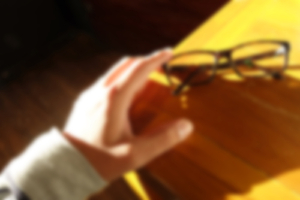6 Signs You May Have A Cataract
Concerned that you could have cataracts? Cataracts cause your lenses to grow cloudy as proteins break down in the eye. This condition is common due to aging and, among other things, can cause vision loss. Keep reading for 6 signs you may have a cataract!
1. Cloudiness

Once you’re in your forties or fifties, you become more likely to develop cataracts. Cataracts develop when the lens becomes cloudy, which occurs when proteins in the lens begin breaking down and make it harder to see.
Cell protein breakdown causes this change. You may not notice blurry or foggy vision immediately, but it is often the first sign of cataracts.
As you age, experiencing cloudy or foggy vision often gets worse. Your eyes may appear milky or clouded to people looking at you.
This effect often limits vision in the center of your field of view. It can make tasks like reading or driving harder to accomplish.
The broken-down proteins prevent light from entering your eyes. Everything can appear cloudy or blurred. If you’re trying to drive at night, you may experience distracting glare or halos, which can even become dangerous to you and others on the road.
2. Trouble Discerning Colors

As cataracts worsen, you might notice that the world isn’t as bright as it once was. The proteins in the lens limit light and make it more challenging to see in color.
Instead of vibrant magenta, you may see a bubblegum pink hue. Everything can look duller. It’s common to have difficulty seeing blues and purples as cataracts progress.
You could also experience the world through a yellow or brownish tint. Cell protein breaking down can cause this discoloration. It’s like looking through the world in a sepia camera filter. Instead of seeing things as the brilliant white you know they are, the world may start to look muddy.
3. Changing Prescriptions
Often, people who have cataracts become nearsighted. They have difficulty seeing far away. Those who were nearsighted before developing cataracts have sight that worsens when trying to see things that are far away.
It is critical to attend regular eye exams to learn if you need new prescriptions. Cataracts may develop slowly or rapidly. It’s not unusual to change prescriptions yearly or more often. You may need more frequent prescriptions for your glasses or contact lenses when you have cataracts than ever before.
4. Double Vision

Double vision is also called diplopia. You may have this symptom if you see two images when looking with one eye.
This symptom happens because cataracts intercept light entering the eye. Instead of seeing a complete image, you may see fragments of the picture.
Many people who have cataracts see two incomplete images next to each other. Diplopia often goes away as cataracts become more severe and you lose sight.
5. Sensitivity to Brightness

Cataracts can distort light and can make it appear brighter. You might avoid bright light or close the curtains to minimize sun exposure.
Some people squint to reduce discomfort. Others close their eyes when exposed to too much light. You may experience headaches from this increase in brightness.
6. Reduced Night Vision
You may not notice cataract symptoms as much during the day. When the sun goes down, they can start to become more apparent. You might have reduced vision in the center of your eyes.
Passing car lights may appear extra bright, making your pupils rapidly grow smaller. It can be difficult to readjust your eyes once a car passes because clouding limits the light that enters the lenses.
Some say their overall vision has dimmed because of cataracts. This symptom is easier to see at night when there is less light.

Your eye doctor can recommend whether it’s safe for you to drive with cataracts. Lack of night vision can be a determining factor of when you can safely be on the road. If you feel unsafe while driving at night, find a friend or family member that can get you where you need to go until you have cataract surgery.
Diagnosing Cataracts
You may not notice vision changes during the early stages of cataracts. That’s why it’s essential to have regular eye exams.
How often you should see your eye doctor for eye exams depends on several factors, including your age, eye health, and if you wear glasses or contact lenses. If you’re unsure of when to see your ophthalmologist, ask them to recommend a schedule that you can follow.
During your eye exam, eye doctors perform visual acuity tests to assess your sight abilities. You will cover one eye while reading a list of letters in different sizes. Then, you will cover the other eye and repeat the test.
Next, the doctor will use a slit lamp to look for abnormalities. This device creates a bright line of light to illuminate individual parts of the eye. This test examines the lens, iris, cornea, and area between the cornea and iris.
Finally, the doctor may perform a retinal exam. You’ll prepare by receiving eye drops that dilate your pupils. It takes about 30 minutes before your pupils will be dilated.
The eye doctor will use a slit lamp or ophthalmoscope to see far into the retina. Cataracts will appear as cloudiness, alerting your eye doctor if you have any changing vision needs.
You may treat mild cataracts with prescription glasses or contacts. People whose cataracts lower their quality of life have cataract surgery that removes the eye’s natural lens and replaces it with an artificial lens.
Removing the natural lens removes the cataract and gives you back your clear vision. For many people, having cataract surgery and choosing an artificial lens (also known as an intraocular lens or IOL) means they end up with the best vision they’ve ever had!
Having cataract surgery is the only way to permanently treat cataracts. Any other treatment that claims to do the same is not accurate.
Eye Consultants of North Dakota is a patient-focused practice located in Fargo, ND. Our experienced eye care team offers exams and prescriptions for all ages.
If you’re concerned that you may have cataracts, schedule an appointment at Eye Consultants of North Dakota in Fargo, ND, to find out now!



